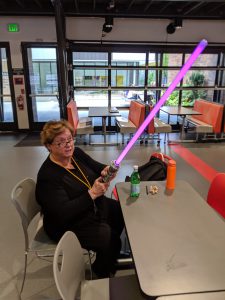(1) coaches and reinforces peer-to-peer dynamics that are appropriate and constructive
(2) communicates behavioral expectations that are appropriate to class activities
(3) develops a mutually respectful relationship with each student, instilling confidence that the teacher is invested in their success
(4) demonstrates cultural competence by promoting inclusivity
(5) designs and facilitates a classroom culture that promotes student preparedness, engagement, self-advocacy, perseverance, and collaboration
My fundamental philosophy for classroom culture is that everyone wants to be in a classroom that is engaging and allows them to be themselves. Students are often worried about the impression they are making on others and they have a difficult time letting go and embracing the opportunities in front of them. I build classroom culture by encouraging students to take risks and doing my best to help others recognize and honor the risks being taken by their peers. My hope is that I can help them see the growth that can occur when risks are taken and help them to develop the confidence to take the same risks outside the classroom, when they don’t have the same safety net of classroom culture.
(1) Coaches and reinforces peer-to-peer dynamics that are appropriate and constructive
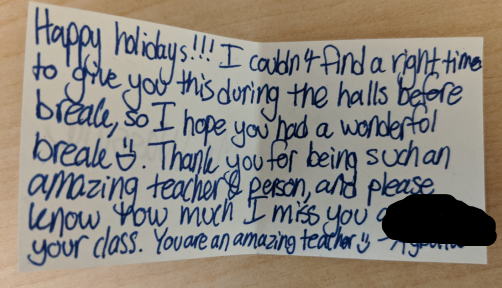
In order for students to feel comfortable and relaxed to allow for maximum learning they must have confidence that the risks they take in the class will be supported and honored by the teacher as well as their peers. In all interactions the conversation is steered toward questioning the content and encouraging the person. Here are a few of the ways this gets built:
- Table groups of 4-5 students that often have small discussions
- Whole class discussions vary from facts and fundamental content to ethical debate
- Whiteboard, kahoot, and skills tests that give immediate feedback and encourage additional practice
- Peer feedback from presentations anonymous and coached by teacher in advance
- Group work in designing and implementing lab procedures, theory and application of themes.
(2) Communicates behavioral expectations that are appropriate to class activities
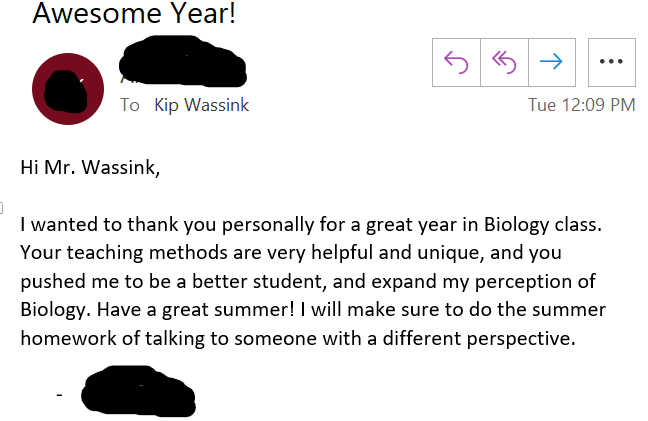
All interactions that occur during class should be able to be traced back to learning biology and a deeper understanding of our Major Themes. There are different expectations for talking, movement and interaction for the major activities class. These criteria are not dictated by me but developed as a class based on a discussion at the beginning of the year. The basics are outlined below:
| Class Lecture and/or discussion
|
One person talking at a time Questions and critique directed at the evidence and logic, not the person Follow basic Harkness discussion protocol (students are familiar with this from other classes) |
| Laboratory activity | Lab Safety rules learned by a class scavenger hunt then discussed – remember Safety Third First time students use equipment is it set up and explained by me. After that, they are expected to find it, set it up and put it away on their own. Mood is easygoing, often music is playing sometimes thematic for the lab, sometimes student selected |
| Independent work time | Students are working on self-selected activities. Assignments, studying or extension learning are all frequent occurrences Lab, discussions, notes, watching videos are all common. Unifying expectation is that everyone is working on biology |
I always intend to have the expectations posted visibly in the classroom, but with 5 different classes in the same room I have never figured out a good way to make that work.
(3) Develops a mutually respectful relationship with each student, instilling confidence that the teacher is invested in their success
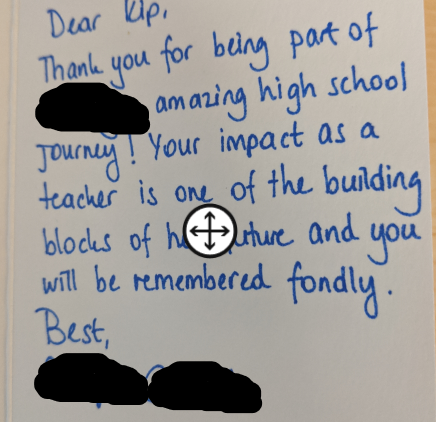
This is more fully developed in the section on Relational Cultivation but the basics involve treating each student like an individual. Getting to know their learning profile, hobbies and interests as well as gathering perspective from advisors and other teachers. All of this is very time consuming, but made much easier if time is set aside to wander campus, visit other classes and be involved in things outside the classroom. Overall, this personal knowledge and connection enables me to help find an appropriately challenging as well as engaging path for that student to engage in material for class.
(4) Demonstrates cultural competence by promoting inclusivity
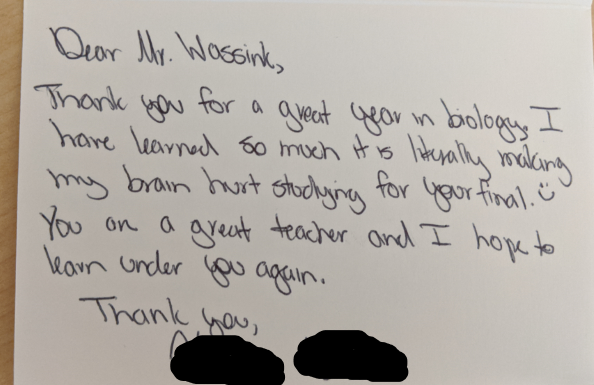 Also discussed more extensively in the section on Relational Cultivation but each student must feel like they are personally part of the class. Their voice is heard, their opinion matters, and the content is relevant to their life. It’s easy to design a class that covers biology and when students find it boring fall back on the excuse that they need to learn to apply themselves and develop some grit. There is definitely a time and place for developing perseverance, but it shouldn’t be every time they come to one particular class.
Also discussed more extensively in the section on Relational Cultivation but each student must feel like they are personally part of the class. Their voice is heard, their opinion matters, and the content is relevant to their life. It’s easy to design a class that covers biology and when students find it boring fall back on the excuse that they need to learn to apply themselves and develop some grit. There is definitely a time and place for developing perseverance, but it shouldn’t be every time they come to one particular class.
(5) Designs and facilitates a classroom culture that promotes student preparedness, engagement, self-advocacy, perseverance, and collaboration
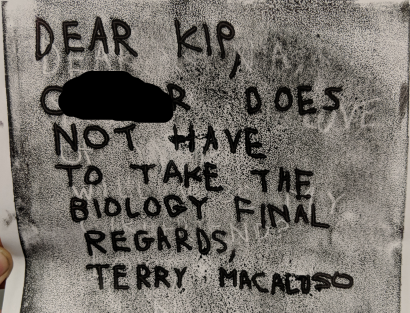
This concept is pervasive throughout the class, but the idea of a low floor high ceiling activity illustrates my philosophy best. Jo Boaler wrote a great article about how to use these activities to help students develop a Growth Mindset. Many math examples can be found on this spreadsheet Low Floor High Ceiling examples (Dan Meyer). The most important idea is to introduce the topic in a way that opens the door for many levels of response. Students are often looking to find “the answer” and I find that they are very good at reading teachers by the time they get to 9th grade. There are days where I flat out tell students that I will be trying to confuse them and arguing against their ideas. Their job is to find the boundary between what they can prove and what is still intuition. The next step is mapping out a plan of attack to find or collect the evidence necessary to prove their hunch (hypothesis). The pattern of thinking has its specific nuances for each discipline, but the fundamental thinking is the same. You must use data and evidence in a logical manner to reach conclusions and then implement a plan based on those results. Then, you repeat and seek new perspectives to see if there’s new evidence or a different way to tell the story.
Looking to the future I want to improve my ability to facilitate the development of a strong sense of support between the incoming students and those who have been at EPS for years. As 9th grade is a key expansion year for Eastside Prep, this is going to be increasingly important to keep our personal and supportive culture through the upper school. The last thing anyone wants is for this school to become a competitive stress tank focused only on competitive collegiate acceptance. If we are going to resist that slide, we will have to fight for it. 